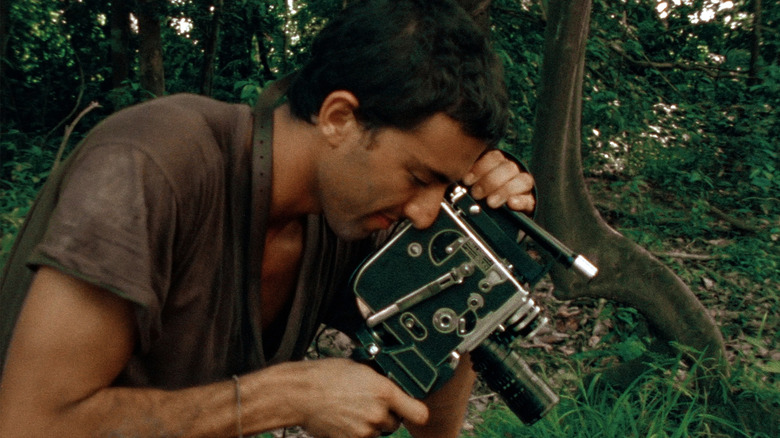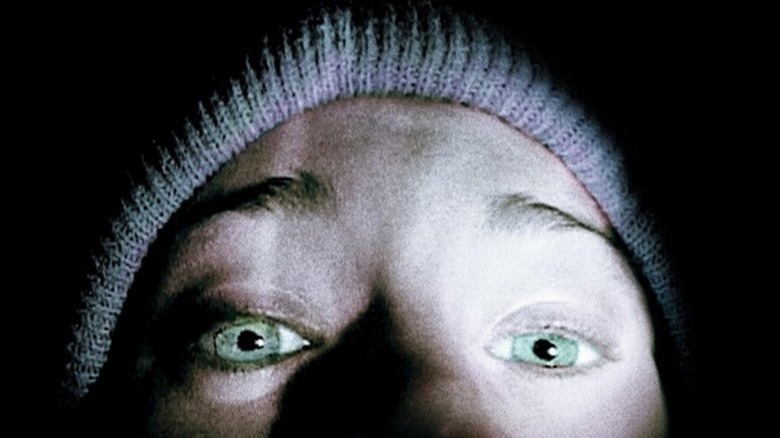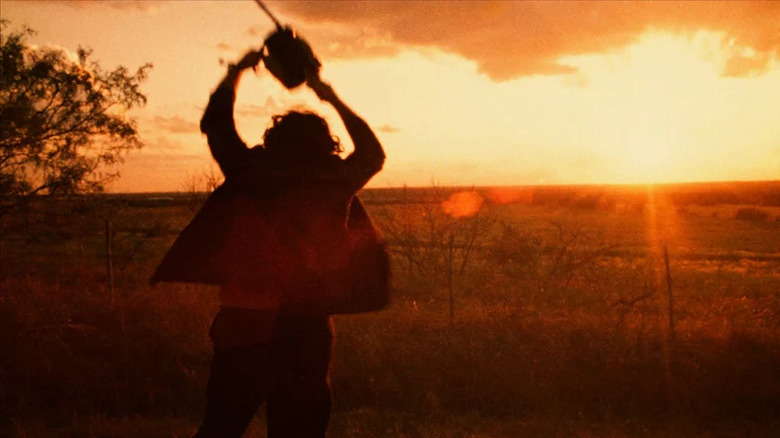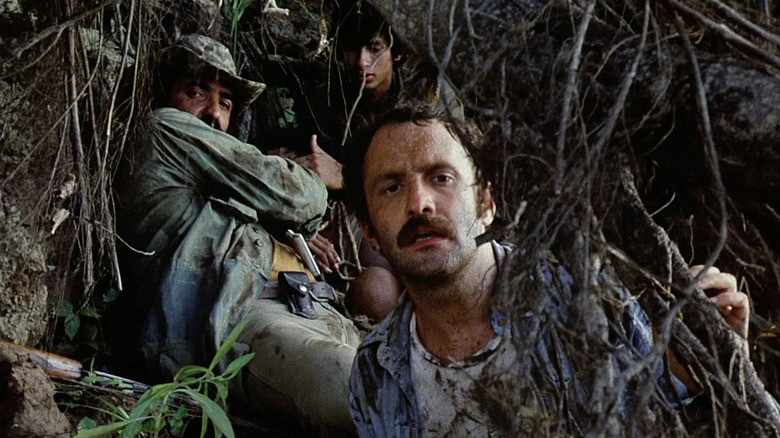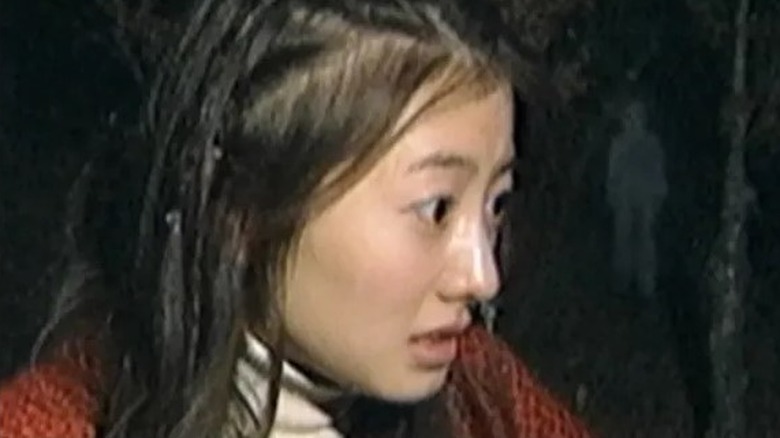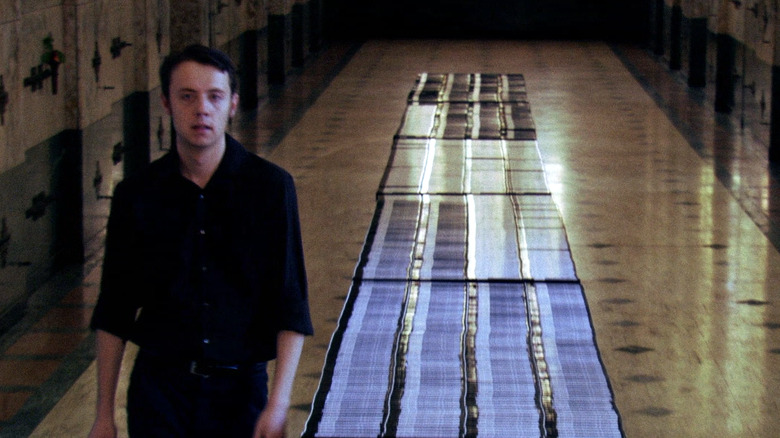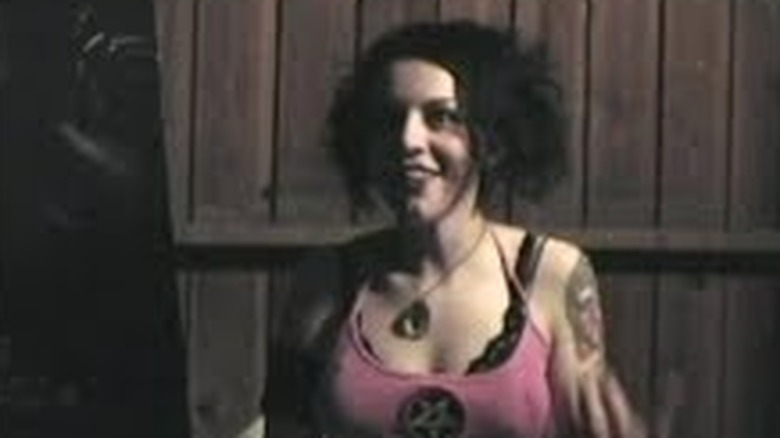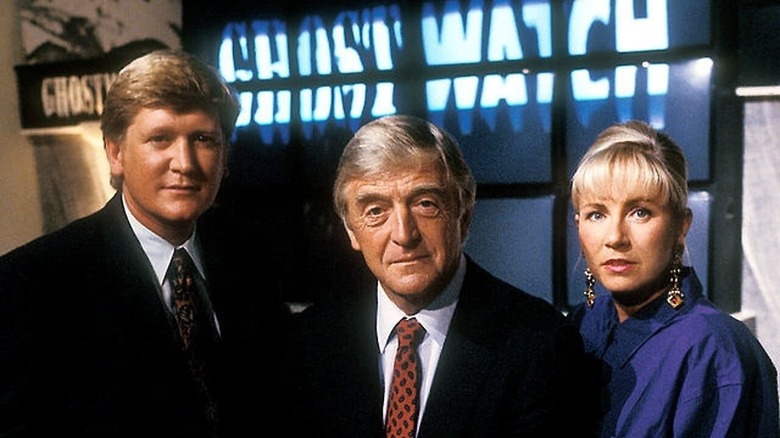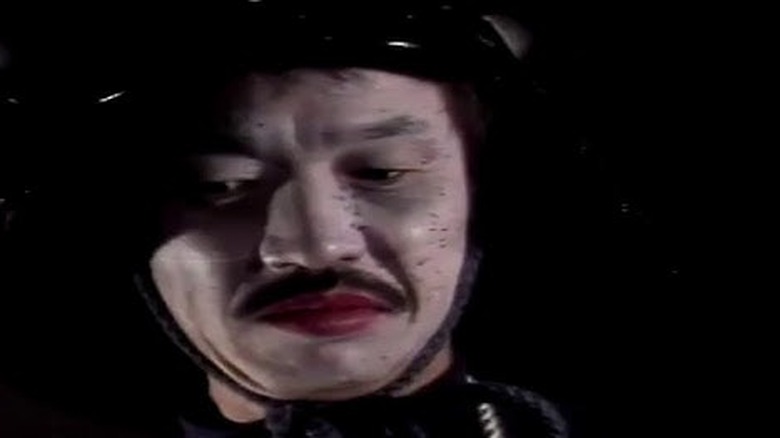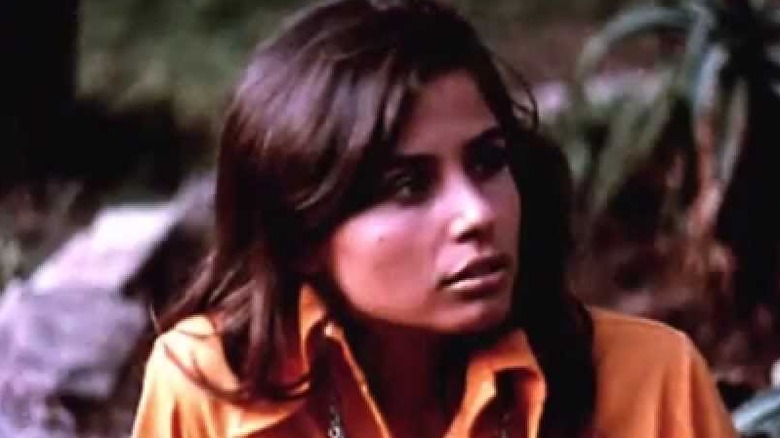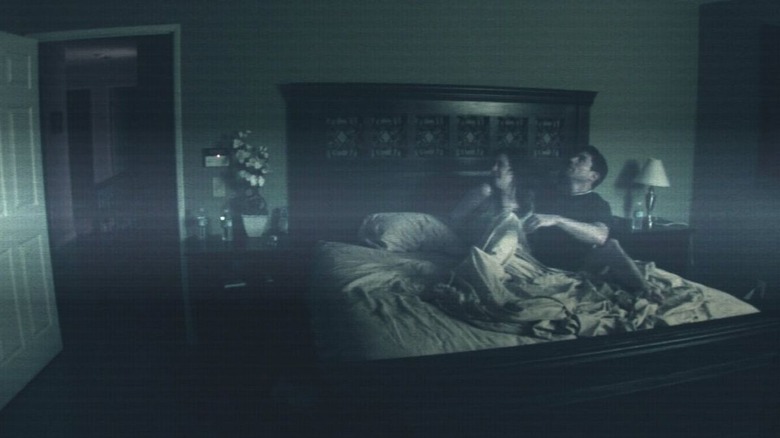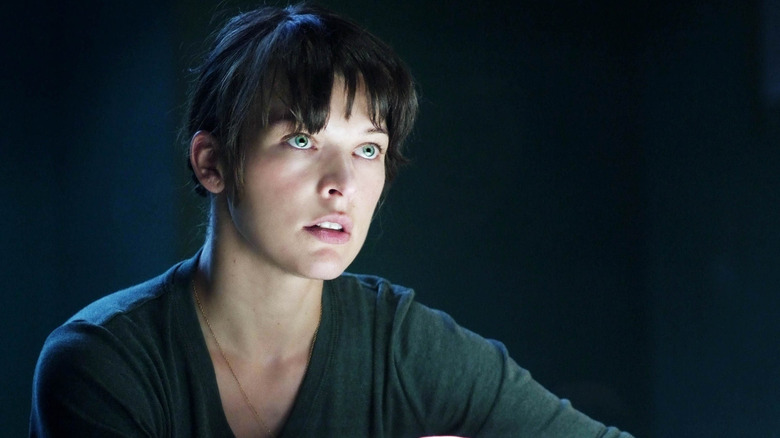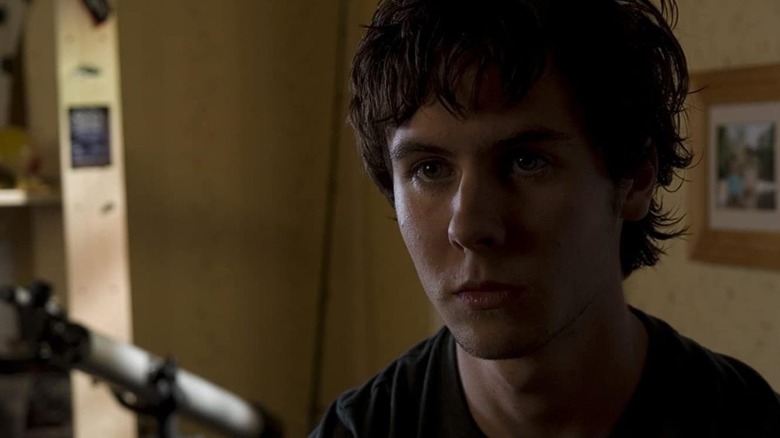Horror Movies Audiences Believed Were True
Engulfing audiences in a cinematic world where the line between reality and make-believe become blurred is the stuff movies are made of — but what happens when the movie becomes so visceral, we start to question its truthfulness?
Horror films in particular can walk that fine line of clever filmmaking and creating an unsettling, nagging feeling that what we're watching is someone's actual terror. Many of these films use the pseudo-documentary/mockumentary style to disarm audiences, conflating a typically non-fiction setup with entirely fictional elements. Meanwhile, others rely on crafty marketing campaigns to stir up curiosity, suspicion, controversy, or all of the above. Whether a movie informs audiences that the story ahead of them is based on true events or the director opts for frenetic handheld camerawork, there are some movies executed so well that movie-goers will debate their authenticity long after the credits roll.
A subgenre that has existed for decades, horror filmmakers seem to relish the idea of creating something so frantic and horrific that audiences can only process them as real. To celebrate this cinematic sleight of hand, we look back at some of the best horror movies that audiences believed were true.
The Blair Witch Project (1999)
Released in 1999, "The Blair Witch Project" brought the found footage trend into the mainstream with a truly independent film that hinged on the premise that the movie watched was the discovered work of three filmmakers who had purportedly gone missing. The movie itself took advantage of the unsettling shakiness of guerrilla-style filmmaking to elevate the panic and tension of the trio as they fight for their lives against the unseen mythical Blair Witch. As we ran around the forest floor and navigate a dark basement with the group, it was easy to get caught up in the uneasiness — even Stephen King found "The Blair Witch Project" too scary to finish.
What elevated this tension even more was the ingenious marketing campaign that preceded the opening of this film at a Midnight Screening at the 1999 Sundance Film Festival. The filmmakers set up a website devoted to the missing filmmakers and the efforts being made to find them. Fake police reports, interviews, news reels and photographs were posted to the website, and they even went as far as to alter the IMDb pages of the three actors (whose characters shared their full names) listing them as "missing, presumed dead."
Today, it's unlikely such a swing could connect, but in 1999 with the internet still in its infancy, it felt more likely than not that we were watching the actual harrowing lost minutes of three young people who met their fate at the hand of an urban legend. It's just a hame the cast hasn't been compensated fairly for their contributions to the movie.
The Texas Chain Saw Massacre (1974)
At present, there are nine entries in "The Texas Chainsaw Massacre" franchise, and while the films vastly range in terms of quality, the original 1974 release from writer-director Tobe Hooper and co-writer Kim Henkel stands shoulders above them all. Considered to be a landmark of the slasher genre, Leatherface's bloody and gruesome take down of a group of friends road tripping through Texas was largely inspired by notorious serial killers Ed Gein and Elmer Wayne Henley. Hooper captured Leatherface's vicious murders with such detail, authorities banned the film in multiple countries across the world.
Marketed as a film based on a true story, the misdirect coupled with the grisly scenes of the film successfully gave audiences plenty of pause in deciphering whether the crimes of Leatherface had in fact happened. In actuality though, "The Texas Chain Saw Massacre" was a work of fiction, in spite of its opening narration promising audiences that the events to come really did occur. If anything, the discourse that followed (and continues to this day) is a testament to Hooper and Henkel's fastidious research and detailed approach to filmmaking.
Cannibal Holocaust (1980)
Widely regarded as the first film to utilize found footage, "Cannibal Holocaust" follows an American rescue team that goes into the Amazon to find a film crew thought to have gone missing while making a documentary about local cannibal tribes. Eventually, the team find the remains of the film crew, as well as reels of film, which the team barters for and returns to America. Upon watching the reels, the heinous acts of the crew infiltrating the tribe are discovered, including scenes of assault, murder, destruction, and dismemberment.
The DVD extras of "Cannibal Holocaust" revealed a grave discomfort among the cast and crew filming many of the graphic sequences, as well as the genuine murder of animals on film. The visuals were so graphic that following the film's premiere, director Ruggero Deodato was charged with murder and required to testify as to how an impalement scene was filmed and the Earthly existence of the actors the court deemed to have been killed. Eventually, Deodato was cleared of murder, but he was fined for animal cruelty, and in many ways, it's the controversy surrounding "Cannibal Holocaust" that has given the film a cult following.
Noroi: The Curse (2005)
Building off of the success of "The Blair Witch Project," a meta pseudo-documentary in Japan called "Noroi: The Curse" presented a paranormal researcher in search of answers to a series of set of unexplainable events. The researcher identifies a demon named Kagutaba as the source of these mysterious deaths as the film escalates into a series of suicides and demonic possessions.
Considered to be one of the best folk horror movies ever made, many of the gritty scenes in "Noroi: The Curse" contain sheer horrors with great detail, including one where a woman pours gasoline on herself before setting herself on fire. Part of what made "Noroi: The Curse" so believable was some camera trickery that saw organic glitches alter the film. Director Kōji Shiraishi used the inherent qualities of corrupted tape as a means to deform character's faces and freeze the image as audible panic and horror takes over. Coupled with the participation of a well-known Japanese actress in the "documentary," Shiraishi created a film that played with an audience's ability (or lack thereof) to decipher reality from fiction.
The Poughkeepsie Tapes (2007)
Another pseudo-documentary film, "The Poughkeepsie Tapes" follows the discovery of 800 snuff films made by serial killer Edward Carver. As the police go through each film, we're taken through Carver's recordings, each showing his many heinous crimes against children, teenagers, and prostitutes. "The Poughkeepsie Tapes" is a difficult watch and one of the scariest found footage films around, but director John Erick Dowdle stops short of showing every detail, which only adds to the psychological mind games the film plays on its audience.
It wasn't the imagery or crudeness of the footage that spurred rumors of "The Poughkeepsie Tapes" being actual found footage, though. For almost a decade, the film existed in a cinematic purgatory. Having premiered at the Tribeca Film Festival in 2007, MGM purchased the film for distribution, but "The Poughkeepsie Tapes" didn't see the light of day until 2014, when it was given a brief video-on-demand release, only to go off the market and disappear once again.
Conspiracies surrounding the release of this film ranged from the extreme, where the families of the victims threatened to sue MGM, to the mundane, where the studio simply wanted to give the film a theatrical release but lacked the opportunity. It remains unknown why MGM kept "The Poughkeepsie Tapes" on its shelf for so long, but it only served to heighten the mythical discourse around the film.
August Underground (2001)
In his directorial debut, Fred Vogel directed, produced, co-wrote, and starred in "August Underground," a film about a serial killer (also played by Vogel) who terrorizes, imprisons, assaults, and murders women. The film uses a first-person visual perspective to elicit a shocking response derived from seeing the actual pain and fear a serial killer conjures.
In discussing the legacy of the film on The Eric McKenna Project in 2020, Vogel recalls sending the film out to critics in the hopes of garnering reviews and receiving the feedback that people thought Vogel was "really killing people because the movie looks very realistic." This notion even went so far as to being detained by Canadian border authorities when he attempted to enter the country for a film festival with "August Underground" in his possession. Charged with 16 counts of breaking obscenity laws, Vogel seems to relay an understanding of why this happened: "It's like a snuff movie — you think what you're watching is real."
Ghostwatch (1992)
Presented as live television (although previously recorded), "Ghostwatch" aired on BBC1 on Halloween night 1992 as a program hosted by renowned English television presenter Michael Parkinson. The idea behind the show was to investigate a home in a fictional part of London that was being haunted by a poltergeist. As the show continued on, a ghost story emerges with possessed individuals confessing their stories of murder and sexual assault.
According to the BBC, more than 20,000 people tried to contact Parkinson during the show's broadcast, believing the presenter to be in grave danger. In the end, the broadcaster received thousands of complaints from viewers, many terrified of what had just been broadcast. Some were seemingly angry about the broken trust between them and the BBC, but others praised the show for its creativity.
While it's safe to assume that the BBC never intended to cause anyone harm by this spoof, real-life consequences did prevail when a family pointed the finger to the program as the cause of their son's death. "I knew it was that program," the deceased's father said, after being made aware that his son took his own life. This unfortunate aftermath caused the BBC to distance itself from the show, and "Ghostwatch" was never broadcast again.
Guinea Pig 2: Flower of Flesh and Blood (1985)
Released in 1985 as the second of the "Guinea Pig" series, "Guinea Pig 2: Flower of Flesh and Blood" follows a serial killer who abducts his female victims and then proceeds to dismember their bodies, adding them to a larger collection of human remains. The film became an international phenomenon for its disturbing and nauseating sequences — it was even thought to have been the inspiration for real-life serial killer Tsutomu Miyazaki who murdered four young girls in the late '80s. (Although director Hideshi Hino claims this to be misreported, and it was actually "Guinea Pig 4" that was found in Miyazaki's home.)
All that said, the notoriety of "Guinea Pig 2" actually derives from none other than Charlie Sheen. As the story goes, film critic Chris Gore met Sheen in 1991 and decided to pass on his copy of the film to the actor. After watching "Guinea Pig 2," Sheen allegedly believed the movie to be an actual snuff film and contacted the authorities immediately. The FBI confiscated the tape and launched an investigation, but according to Hino, the case never found its way to court. Still though, the movie was visceral enough to convince Sheen he'd just seen a legit serial killer on screen, and that was long before he was on tiger blood.
Snuff (1976)
Based on the Manson Family murders, 1976's "Snuff" spends the majority of the film concerned with a biker cult gang in South America led by a man who stalks and kills a pregnant young woman. In the final scene of the film, which was a last minute addition, director Michael Findlay opts to break the fourth wall and has the camera pull away to show the filming crew and set. As the cameras continue rolling, the "director" begins flirting and eventually making out with an actress, only for him to be suddenly taken by an urge to murder her. As he mixes sexual pleasure with physical violence in those final cinematic moments, "Snuff" earns its title wholly and truly.
In an interview with About Film, adult film director and actor Carter Stevens (whose adult film studio was used to shoot the final scene) remembers seeing picketers and news outlets lined up at the film's premiere. Assuming that the film's producer Allan Shackleton had hired the protesters to drum up some controversy, Stevens called Shackleton to confirm his suspicions. As it would turn out, Shackleton had intended on hiring people to create manufacture a protest, but he hadn't quite done it yet. The people marching back and forth outside the theatre to decry the film as actual snuff had come to this conclusion all on their own.
Paranormal Activity (2007)
Cited as the most profitable horror film ever made, "Paranormal Activity" rests on the simple premise of a woman believing that she's haunted. To put her fears at ease, her partner decides to mount a camera in their bedroom to record any suspicious activity while they sleep. The camera ends up capturing eerie behavior, including the woman waking up in the middle of the night, standing next to her partner, and staring at him for two hours, culminating in one of the best movie endings I've ever experienced.
By the time "Paranormal Activity" premiered in 2007, found footage films became the norm in the genre; however, this didn't stop the imaginations of young movie-goers running wild, and it reinvigorated the subgenre. Because of the simplicity of the film and the simple camera work used, there's a voyeuristic quality to "Paranormal Activity," as if we're watching real security footage and home videos. With minimal special effects used, the entire film is quietly believable, right up until the final shocking seconds. By that point, audiences have bought in so wholeheartedly that we couldn't help debate that maybe — just possibly — "Paranormal Activity" was real.
The Fourth Kind (2009)
Another pseudo-documentary that really lays into the concept, "The Fourth Kind" begins with actress Milla Jovovich telling audiences she will be playing a real person, psychologist Dr. Abigail Tyler — a tactic reminiscent of Orson Welles' introduction to his 1938 radio drama, "War of the Worlds." Jovovich continues to explain that all scenes in the film have been recreated from fact, including those involving kidnapping, murder, and alien abductions, warning audiences: "Please be advised that some of what you are about to see is extremely disturbing." Director Olatunde Osunsanmi even goes as far as mocking up archival footage with a different actress that's shown side-by-side to Jovovich's reenactments.
Taking a page from the successful marketing campaign of "The Blair Witch Project," Universal Pictures created a website containing fake articles and stories about the events of the film, attributing them to actual Alaskan newspapers. This strategy gains even more controversy when considering that Nome, Alaska, where the film is set, did experience an uptick in missing persons, when 24 people went missing between 1960 and 2004. In a small community such as Nome, these disappearances arguably hit harder and resulted in many conspiracy theories cropping up to explain this anomaly, one of them being alien abduction. While Nome expressed their dissatisfaction with Universal for preying upon their hardship, there also existed the nagging thought that maybe "The Fourth Kind" presented more fact than fiction.
Lake Mungo (2008)
Unlike some of the other titles on this list, the believability of "Lake Mungo" lays largely with the performances and subtle storytelling, as opposed to graphic displays of violence. Similar to others on this list though, director Joel Anderson uses the pseudo-documentary style of filmmaking to tell the story of a family grieving over the untimely death of their 16-year-old daughter, Alice, with great effect. Set in Victoria, Australia, "Lake Mungo" presents itself as a traditional documentary with talking heads explaining a seemingly factual event under extraordinary circumstances.
Members of Alice's family offer their perspective on her passing and the strange happenings that occur in the home after her death, leading them to believe that the young girl is haunting them. The family hires a psychic with the hopes of finding closure.
"Lake Mungo" goes from strength to strength as it moves from genre to genre — mystery to horror to supernatural to thriller. The film is entirely a work of fiction but the natural performances by the ensemble truly sell the documentary as a family confronted with the worst type of grief imaginable. Add in the stunning direction by Anderson, "Lake Mungo" captivated audiences through some of the best storytelling seen in the genre.
